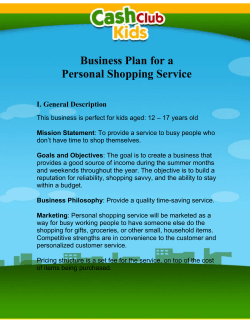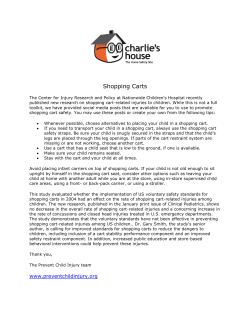
aDDinG art DEVELOPMENT text: mr. valentin kennDler, imaGes: stary Browar, ses, artware
development Adding Art How to merge commerce, leisure, and culture in shopping centers Text: Mr. valentin kenndler, Images: Stary Browar, SES, artware 34 In today's shopping centers, the combination of shopping and leisure has become a standard recipe. As markets get more saturated, another ingredient needs to be added. When IKEA Moscow designed their airport-sized development, set to open in 2012, they decided on a unique spice: artwork. But the artwork chosen was much more than mild flavoring. The pieces were a key ingredient to position and brand the retail park. IKEA picked internationally renowned artists to develop commissioned works placed in the highly visible parking area. While Piotr Uklanski developed a large-scale sculpture, vis ible from the 16-lane motorway, Danish artist Jeppe Hein will place a mirrored labyrinth comparable to the project he realized in Chiswick Park (London), opposite the building's façade. Other artists are also involved (including Russian artists), and the art has one thing in common: The pieces are not just eye catchers but intelligent works that evoke feelings, touch people, and provide intense experiences for the visitors. No matter whether you revitalize or build something new, art can be a key addi tion to transform a shopping center into a cultural entertainment destination. Another advantage is that there are very few examples so far. In the following basic recipe I would like to explain what art can and cannot do in shopping centers, beginning with positioning and the idea of the experience economy and moving on to how to measure the "return on the investment" of the artwork used. Positioning, positioning, positioning Contemporary art represents certain values in our society. It stands for inno vation, luxury, and individuality, attributes that are usually very positively rated by consumers. When implementing contemporary artwork into your shopping center, these values can be transferred to your center, thereby distinguishing it from the competition for potential visitors. However, art might also be associated with disputed values. When "The Tree", by renowned artist Jonathan Borofsky, was opened in Europark Salzburg, a heated discussion was sparked: Is it a sculpture, or is it a billboard? Is it art, or is it commerce? Why is this distinction so important? If art becomes commerce, it instantly loses its magic and attractiveness, although it is still as attractive as a billboard. Artwork can, of course, consist of logos (such as the Campbell's Soup cans by Andy Warhol), but the INTENTION must not be advertising. Warhol was critically reflecting consumer culture of the 1960's. To cite another example, we did a project with Austrian artist Friedrich Biedermann, who developed a two-meter lighting piece, putting a second moon LED panel on our client's rooftop. The artist worked with the subject of broadcasting (the client is in the media industry) and decided to integrate logos of TV stations in the LED panel. These logos, which move slowly, are zoomed in on and turn, make a reference to the client but do not intend to advertise. In fact, they are an integral part of the artistic message. Art only works next to commerce, not as a part of commerce. The experience economy The basic idea that our economy developed from an agrarian, industrial, and service economy to an experience economy is not new (Pine and Gilmore 1998). Nevertheless, the conclusions derived from that thesis were often incorrect, leading to Planet Hollywood-like environments. Of 95 Planet Hollywood res taurants only 14 still remained after bankruptcy in 1999. What went wrong? In my opinion, planners underestimated the relevance of authenticity. Visitors and consumers want to have a real experience, not an artificial one. Grazyna Kulczyk, Poland’s wealthiest women and art collector, revived the historic setting of the 19th century industrial architecture in the Poznan´ center. Stary Browar combines commerce (200 shops and restaurants, 8-screen cinema) with art in an exceptionally consistent way. 35 development Interestingly enough, authenticity is also a major factor in the art world: 8.5 million guests visit the Louvre in Paris, mainly to see the original Mona Lisa by Leonardo da Vinci. It should be noted that today's prints of the Mona Lisa are of such high quality that only experts see the difference between the copy and the original. Nevertheless, it is the aura of authenticity that attracts visitors to the Louvre. When combining unique artwork with shopping centers, you provide an authentic experience that touches your visitors. While location, tenant mix, etc. form the entrée of your meal, generating a unique experience is the seasoning. The Savoy Restaurant in Moscow and the Noma in Copenhagen are not famous for their amazing cooking; they are famous for the experience they provide. From shopping center to cultural forum Grazyna Kulczyk, Poland's wealthiest woman and art collector, revived the historic setting of the 19th century industrial architecture in the Poznan ´ center. Stary Browar combines commerce (200 shops and restaurants, 8-screen cinema) and art in an exceptionally consistent way. It became a cultural forum with a permanent exhibition, regular openings, design events, and performances. Ms. Kulczyk, now sometimes called "Madame Browary," created a cultural forum instead of a shopping center, a place where "business advances art, and art advances business." Since this endeavor enhances the attractiveness of the whole region, it is also an investment in the relationship with all stakeholders, not only consumers but also politicians, investors, NGOs, etc. Accordingly, adding art is not only good advertising, nowadays shopping centers must succeed on the product market AND the market of local opinion. Art is an investment in longterm relationships and trust with the stakeholders. When "The Tree," by renowned artist, Jonathan Borofsky, was opened in Europark Salzburg, a heated discussion was sparked: Is it a sculpture, or is it a billboard? Is it art, or is it commerce? This also holds true for media relations, as is proven by the coverage of Stary Browar, from Newsweek to Playboy. Print and television media are always searching for both untold stories and stories that have a face, that you can visualize. Art and shopping centers provide exactly such a story. On one hand, the topic itself is relatively new, on the other hand, it is easy to transport visually; consider the assortment of photos and images in this article. This relative attractiveness of art and shopping centers simply translates into media value for the shopping center, facilitating the communication measures and attracting more customers. What kind of art is most effective? When it comes to art, anything is possible: from cast bronze sculptures to street art, from oil on canvas to lighting pieces or video installations, from temporary exhibitions to permanent 36 DK Copenhagen Gdansk Lübeck Hamburg-Moorfleet Beijing Warsaw, Targowek Domoteka PL Oldenburg Warsaw, Janki DE CHINA Reims Wuxi Paris Bry-sur-Marne Essen Cologne-Butzweiler Cologne-Godorf Koblenz Frankfurt-Wallau Würzburg Saarlouis Mannheim Ulm Lodz Lublin Czestochowa Wroclaw Katowice Rzeszów Prague CZ Ostrava Brno Linz Vienna SK Bratislava AT Wuhan Aubonne Shanghai FR Graz CH Zagreb Villesse Lugano IT HR Belgrade RS Milano Bayonne Avignon Valladolid Porto, Matosinhos PT Madrid ES Alicante Jerez de la Frontera EXISTING CENTRES CENTRE UNDER DEVELOPMENT LOCAL HEAD OFFICES COPENHAGEN, GLOBAL HEAD OFFICE YOUR SUCCESS IS THE BASIS OF OURS OVER 1 000 000 m2 GLA EXPANDING 400 000 m2 WITHIN THE NEXT 3 YEARS We develop, own and manage shopping centres in partnership with IKEA. We offer commercially attractive and family-friendly retail destinations that meet the needs of many people. Over the next couple of years we are stepping into new markets in Europe, including Italy and Croatia. We will also start construction of our first centres in China. Join us on our journey. www.iicg.com development Valentin Kenndler advises corporate clients for the firm artware. artware specializes in art and commerce, corporate collecting, and art rental. integration in the architecture, from new artists to internationally established artists. Artwork can be displayed next to a 10-lane highway as a highly visible landmark and in the second floor hallways as a gallery. When choosing the right art, accessibility is a key factor. By accessibility, I mean giving the visitor the opportunity to access a work of art, mentally, in the sense of understanding it and physically, in the sense of interacting with it. Art in public spaces should be "used" by the visitors. The eight-meter sculpture by Franz West in New York City invites passersby to stop, take a seat, and directly engage with the artwork. Interaction also helps bring art within reach, rather than encouraging it to be seen as something reserved for the elite. 38 Just to be clear: accessibility should not be confused with the fine arts, whatever that may be, or with arts by local amateurs. To have a positive image transfer, a professional shopping center must have professional art (if at all). Interestingly, consumers value the presence of contemporary art in general. Not every work of art has to appeal to everyone's personal taste. In fact, it's even better when this is not the case. The artwork should fit the positioning of your shopping center and does not necessarily have to match what visitors buy for their homes. Markitecture – How to evaluate the effect of artwork A shopping center is an investment project with a return. Most investors are very savvy about how location, construction costs, and marketing affect their revenues. But what return is generated by art? NEW EUROPE´S SHOPPING CENTER BLOG On one hand, figures like media value or average length of stay make it possible to evaluate the value art adds to your shopping center brand. sma – Standort Marketing Agentur GmbH has developed an innovative tool called Markitecture, with which the benefits of art and architecture can be made measurable. Shopping centers have to become emotionally charged spaces to which the consumer can build a connection. Brands create security. Rationalize buying decisions; Connect, support, underscore lifestyle, build trust, and form solid associations in the consumer's consciousness. Furthermore, a brand can be effectively supported by architecture. In this sense, the interaction between brand development and architecture seems essential. A question of markitecture! Architecture is the built brand. On the other hand, the cost of artwork is very transparent (artists' royalty plus production), controllable (from new artists to very established artists), and for real estate projects, very affordable. Conclusion When integrated early in the branding process, when the right artwork is chosen, pieces that touch people and allow them to interact, artwork can be a key ingredient in your shopping center, because you provide a core value: quality of life. Because very few examples exist, the early bird advantage amplifies the positioning effect at a controllable and measurable cost. In a world of similar meals every day, art in shopping centers provide a signature dish. STAY ONLINE WITH EUROPE’S SHOPPING CENTERS, AND BECOME AN OPINION LEADER GET DAILY UPDATES on the most important news from the international shopping center industry. Stay informed about the latest openings, and the newest projects. Read concise information on trends and strategies. www.across-magazine-blog.com to ACROSS’ monthly newsletter: office@fishmedia.at
© Copyright 2025















